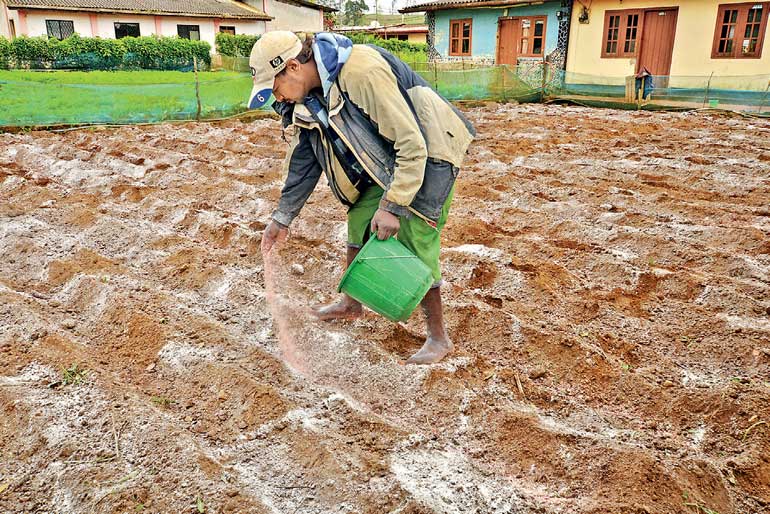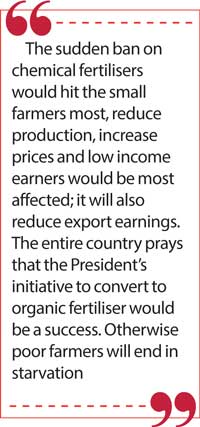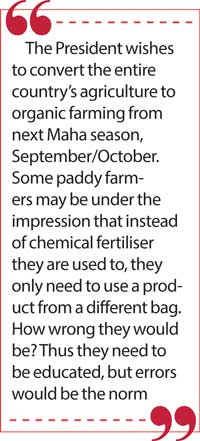Wednesday Nov 20, 2024
Wednesday Nov 20, 2024
Tuesday, 22 June 2021 00:03 - - {{hitsCtrl.values.hits}}

Farmers need to be taught the proper manufacture of quality compost on their own. After harvesting, all left-overs could be used for composting, thus the farmers need to be educated to start immediately for the next season – Pic by Shehan Gunasekara
 President Gotabaya Rajapaksa is extremely interested in moving from current agricultural practice of using chemical fertiliser to organic, in line with his ‘Vistas of Prosperity and Splendour’ policy framework, which stated that the whole agricultural sector of the country should be transformed to use organic fertilisers. His wish is to make Sri Lanka the first country in the world having moved to 100% organic fertiliser cultivation.
President Gotabaya Rajapaksa is extremely interested in moving from current agricultural practice of using chemical fertiliser to organic, in line with his ‘Vistas of Prosperity and Splendour’ policy framework, which stated that the whole agricultural sector of the country should be transformed to use organic fertilisers. His wish is to make Sri Lanka the first country in the world having moved to 100% organic fertiliser cultivation.
The President banned the import of chemical fertilisers in late April and envisages conversion into organic fertilisers from next Maha season (September/October), which would involve massive challenges. The article looks at the possibilities and challenges.
Government policy
Cabinet Co-Spokesman Keheliya Rambukwella announced plans to import carbonic fertiliser for 1.1 million Ha of paddy and other crops for next Maha season. Of the fertiliser requirement for 500,000 Ha would be imported by the State-owned fertiliser company and 600,000 Ha by the private sector. According to Central Bank, in 2020 the country spent $ 259 million on fertiliser imports, up 17% from $ 221.4 million in 2019, possibly due to oil price increase.
But, cut-flower and non-soil cultivators will be allowed to import their own requirements. Earlier the Cabinet had approved the ban import of chemical fertiliser, pesticide and weedicide.
The Cabinet appointed a special procurement committee on organic fertiliser, natural minerals and chelated fertiliser and a Technical Committees specialised on relevant subject to assist the procurement committee and steps to be taken to provide organic fertiliser for the Maha Season farmers.
Chelated fertiliser
In normal application of fertiliser in the field, one-third gets evaporated into air, another -third runs off from water and soil and only one-third is absorbed by the plants, causing serious soil, air and water pollution. In addition, the crop yield declines year by year, forcing the farmer to use higher quantities.
Meanwhile, chelated fertiliser is a slow releasing fertiliser. When applied to soil, release of nutrient within first 28 days is only 15% and 90% nutrients are discharged within 120 days. Thus a slow release chelate fertiliser pack provides 2-3 times of conventional fertiliser. But the cost is only higher by 30%-40% than conventional fertiliser.
Chelated fertiliser is produced by grinding various fertilisers along with trace elements as Fe, Cu, Mn, and Zn and coating the fertiliser to allow slow release. Each producer using a patented production method. Thus Chelated fertiliser is a modified version of chemical fertilisers and the world’s highest producer is China.
 Plantation sector
Plantation sector
An experts committee tasked with overseeing the ban on chemical fertiliser imports has recommended to President not to impose the ban on tea and rubber sectors until sufficient quantities of organic fertiliser are available. In addition, a committee member of the Task Force informed, “There is indiscriminate overuse of chemical fertiliser. This is because of the fertiliser subsidy provided for decades.”
Meeting with private sector
At a President’s meeting with organic fertiliser manufacturers and officials from the Agriculture Ministry, it was disclosed that there are 27 local organic fertiliser manufacturers licensed by the National Fertiliser Secretariat. They claimed the possibility of supplying carbonic fertiliser locally for 224,000 Ha for the 2021/2022 Maha season. The President instructed the officials to inspect the soils at village level before the Maha season, and obtain a report on the amount of fertiliser to be applied.
Organic fertilisers
Fertilisers are added to soils, in order to provide nutrients and sustain growth. Common organic fertilisers start from household level composting of fallen/cut leaves and kitchen waste, possibly in a composting bin or a pit dug in the ground. Composting collected municipal garbage have been successfully practised in a few Local Government Councils with Balangoda Urban Council paving the way, with Bandaragama and Horana Councils where garbage is recycled into compost in an eco-friendly manner.
In addition, garbage mountains at Meetotamulla, Bloemendahl, Karadiyana all have large volumes of collected garbage, already decomposed naturally over the years. If the mountains are handed over to private sector, decomposed garbage can be separated from polythene and metal, balance to be used as fertiliser. However, they need to be analysed to determine quality.
Also waste from chicken, cattle and goat farming result in substantial volumes which could be commercially exploited. In upcountry roads frequently run trucks laden with cow-dung. Cow-dung is popular, but how about cow urine?
Chicken waste to fertiliser
I have personally collected bags of chicken waste from a nearby farm. The owner was happy to get rid of the waste. In chicken farming, paddy husk is spread on the ground prior to sending in the young chicken. Their droppings are absorbed by paddy husk and additional husk is periodically added. After the chicken are moved out, layers of paddy husk with chicken dropping are removed and can be converted into fertiliser.
The chicken waste from the farm cannot be used immediately as fertiliser. I build two brick tanks around three feet high and placed the droppings inside. It was noted that there were small black beetle like creatures among the dung. The lot was kept covered, in a week the temperature rose and beetle numbers multiplied manifold. After three to four 3months waste cooled down and beetles were all dead, having consumed all dung, most have rotted, the paddy husk too had decomposed. I used the lot as fertiliser, but the chemical value or the presence of living micro-organisms is unknown.
Decomposed chicken dung waste has a lot of promise; it may contain decomposed organic matter as well as bacteria, similar to bio-fertiliser, resulting a fantastic combination. A few months ago a major chicken manufacturer, worked with farmers covering nearly 400 acres, possibly with chicken dung fertiliser. Have the Agriculture Department officials made note? If not, they need to go back and collect information for the country’s sake. Similarly all chicken farmers need be persuaded to convert their waste into the best quality organic fertiliser the country can produce.
Compost from sugar waste
The Director General of Sevanagala Sugar Industries claimed they saved Rs. 250 million by stopping the use of chemical fertilisers and the saving would be utilised to build a factory for organic fertiliser.
The company used waste produced in the sugar-making process for the manufacture of compost which was used in sugarcane cultivation. Their research showed that replacing chemical fertilisers with organic fertilisers did not lead to a reduction in sugarcane production. Following the finding, the Company is constructing an organic fertiliser manufacturing facility, expecting to produce 100 tons of organic fertiliser daily. The factory also disclosed that the nitrogen content in the fertiliser in only 2%, thus needing attention.
It was not disclosed whether sugar cane leaves cut off during harvesting were used, also the waste from sugar molasses were added to the compost.
Balangoda Compost Plant
Balangoda Urban Council set up a composting plant to process municipal solid waste into compost. The plant started in 1999 and improved in 2005. In 2008, a faecal sludge treatment plant was established and the compost produced were distributed among the farmers. The nitrogen content of the compost from municipal solid waste and faecal sludge were 1.68 and 2.9 respectively.
Fertiliser quality
Composting is the natural process of decomposition of organic materials by microorganisms under controlled conditions. Raw organic materials such as crop residue, animal waste, green manure, aquatic plants, industrial waste, city waste, food garbage, etc. become suitable for usage as compost or humus of agricultural value.
Farmers need to be taught the proper manufacture of quality compost on their own. After harvesting, all left-overs could be used for composting, thus the farmers need to be educated to start immediately for the next season. In using vegetable matter fresh leaves are the best. Allowing the leaves to dry results in losing value. Thus the material need to be kept wet, away from direct sunlight.
Italian help for organics
Daily FT disclosed that an Italian NGO has been conducting specialised training and awareness programs for the past five years on organic practices among the farmers. Under the project 400 farmers have adopted organic practices. They produce pepper, cinnamon, vanilla, chilli, ginger, turmeric, nutmeg and cloves, with 100 farmers cultivating paddy.
The programme disclosed that conversion into organic agriculture results in low yields during the first few years. Farmers point out that organic cultivation requires more labour than using ready-made products.
 What are bio-fertilisers?
What are bio-fertilisers?
A bio-fertiliser is a substance which contains living micro-organisms, when applied to seeds, plant surfaces, or soil, promotes growth by increasing the supply or availability of primary nutrients. The cultured microorganisms are packed in a carrier material for easy application in the field and are called bio-fertilisers.
Bio-fertilisers are normally manufactured from animal waste including meat processing, manure, slurry and bio-solids. Bio-solids are organic matter recovered from a sewage treatment process. Bio-fertilisers contain living organisms including fungi, blue-green algae and bacteria. These help withdraw minerals from organic matter, nitrogen fixation and convert soil phosphorus into soluble forms, making phosphorus available for plants.
A research conducted in Bangladesh on paddy cultivation, field experiments and farmers’ field trials proved that decomposed organic materials in combination with plant growth-promoting bacteria could compensate at least 30% nitrogen and eliminate 100% tri-super phosphate (TSP) requirement of rice plants without sacrificing yield.
Issues in organic fertilisers
Organic fertilisers can be broadly divided into those produced with local waste and bio-fertilisers produced by large manufacturers or imported. The major issue would be the quality of compost manufactured under different conditions and the quantity and time of application to each crop. Also would the compost give sufficient amounts of chemical requirement of each crop?
With reference to possible organic fertiliser imports, the Environment Minister revealed that there are no laboratory facilities in the country to analyse any organic fertiliser to determine whether it is harmful or not. Before any organic fertiliser is imported, the Government should take steps to ensure laboratory facilities accessible for testing organic fertiliser. But how about those manufactured by local industries?
Liquid organic fertilisers
In the meeting with organic fertiliser manufacturers, a member informed the President that one litre the organic fertiliser manufactured by him is sufficient for an acre and he manufactures 100,000 litres sufficient for 100,000 acres of paddy. The product is expected to be bio-fertiliser. Bio-fertilisers are living microorganisms of bacterial, fungal and algal origin. But if these can be used alone, more likely these would improve performance of normal compost.
Liquid organic fertilisers are concentrated liquids that are added to water prior to application to soil and/or foliage. Liquid organic fertilisers consist of primary nutrient and contain beneficial microorganisms and/or micronutrients. Microorganisms have an important role on the degradation of substrates in the fermentation process.
Organic vs. chemical fertiliser
The biggest issue in the proposed move over to organic fertiliser is non-conducting of proper testing prior to implementation. Here, a series of research conducted by three scientists in Rice Research and Development Institute, Balangoda, Ibbagamuwa during 2003 to 2014 to study the influence of organic manure and chemical fertilisers on rice yield and soil fertility in double-rice cropping system, under organic manure only, chemical fertiliser only, organic manure plus chemical fertiliser and no manure or chemical fertiliser would be relevant.
The research showed the output as follows:
Without any fertiliser: 100%
Using organic manure (OM) only: 130%
Using chemical fertiliser only: 170%
Using chemical + OM: 192%
This shows using exclusive organic fertiliser resulted in only 30% increase, whereas chemicals with organic gave the highest increase of 92%.
Proper testing
Local organic fertiliser manufacturers numbering 27 were licensed by the National Fertiliser Secretariat, but how many have conducted field tests on yields of paddy and other crops as recommended by the manufacturers? Also, were these tests conducted under independent supervision? Thus, all organic fertilisers by local producers or imported need to be tested under dry zone, wet zone and intermediate zones, also under irrigated and rain fed conditions, prior to being used on a large scale.
Quality control
The chemical fertilisers indicate their nitrogen, phosphorus and potassium contents and farmers are familiar of them. But with new organic fertilisers, especially bio-fertiliser, society’s knowledge is almost zero. In addition, each producer basing his production with different raw material, produced quality would be different. How about consistency of the product even under the same manufacturer? Thus quality control of new fertilisers by a State-owned laboratory would be essential.
Compost comprises a mixture of complex forms of nutrients and microorganisms and once applied to soil, it replenishes the soil nutrient pool while improving soil fertility aspects. Therefore, compost application is highly recommended to soils with declined fertility status to improve productivity levels. The standards for compost produced from solid waste management and agricultural waste were introduced in 2003 (SLSI 1246: 2003) by the Sri Lanka Standards Institution.
Compost production by villagers
I am yet to see any TV program enlightening villagers on the production of compost at village level. Few villagers claimed they cultivated paddy/vegetables with compost, but not their composting method. Producing a substantial quantity of compost even for own use require a large quantities of vegetable matter, but availability is an issue. Thus would need to look into availability in the surroundings.
The most important factor is freshness, when vegetable matter dries up it loses a major quantity of its nutrients. Corn plants after harvesting give a large volume, but may need be chopped into small pieces and small scale machinery for the purpose is needed. Also banana after harvesting gives large trunks and also leaves. But whether banana is suitable and a way of converting into compost need to be worked out.
Pesticides
Pesticides have also been banned, but without a solution. The unspoken major cause of the pest problem is the failure of simultaneous cultivation in a season, resulting in pests moving over from one field to the other, increasing in numbers.
These days TV shows paddy cultivators crying for fertiliser, with plants around one month old, meaning they were cultivated around mid-May. Normally, Maha cultivation is harvested in January or early February, are cultivated soon after with irrigation water. In the south cultivation is just prior to Sinhala New Year. Then how did cultivation happen in mid-May? The cause for increasing pests.
Options to farmer
The origin of organic fertilisers for cultivation would be: A. Produced by the farmers themselves with leaves and household waste, B. Recovered materials from large waste mountains as Meethotamulla. C. Decomposed chicken dung waste. D. Bio-fertilisers manufactured by the registered manufacturers and E. Imported fertiliser.
A word of caution
The President wishes to convert the entire country’s agriculture to organic farming from next Maha season, September/October. Some paddy farmers may be under the impression that instead of chemical fertiliser they are used to, they only need to use a product from a different bag. How wrong they would be? Thus they need to be educated, but errors would be the norm.
When the World Environmental Day fell on 5 June, the President Gotabaya Rajapaksa was invited to give the inaugurating speech, respecting his endeavour for moving over to 100% organic. Now, with the entire world watching him, there cannot be turning back.
Foreign speakers too supported the President’s initiative and some informed that they too have moved in the direction, have conducted research and are willing to share their findings. The President needs to direct our research officers to coordinate and obtain information to improve our knowledge.
The country cannot be expected to produce organic fertilisers suddenly for all crops, without prior preparation. Tea and rubber plantation regions do not have quantities of raw materials for converting into compost. Thus tea, rubber and coconut need to be exempted, but could move over to imported chelated fertiliser (detailed above), reducing import costs by 40%. But how about cultivators of potato, onion, corn, etc.?
The sudden ban on chemical fertilisers would hit the small farmers most, reduce production, increase prices and low income earners would be most affected; it will also reduce export earnings. The entire country prays that the President’s initiative to convert to organic fertiliser would be a success. Otherwise poor farmers will end in starvation.